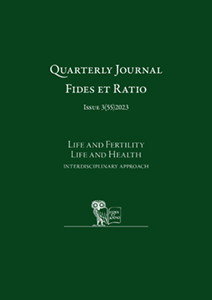Abstract
The article is devoted to individual differences in the field of human musical activity. Musical abilities were taken into account in terms of development, emphasizing the prenatal period of a man. The attention was paid to important aspects in further human development, taking into account heritability and the influence of the environment. They used neurophysiological indicators of changes in development that define neuroplasticity. The importance of characteristics relating to perception, musical intelligence and manual skills was also noted. It is also associated with individual differences in physical activity as a response to music or support in musical performance. The importance of own work in the development of musical abilities was also taken into account. It turns out to be equally important to emphasize the development of musical abilities within the recalling game as opposed to the improvisational one, which is correlated with the variable activation of the neurophysiological task-positive and task-negative networks. The cross-sectional approach to the problem shows the complexity of the musical activity itself which justifies the wide variance of musical abilities analyzed in terms of individual differences which underlie the neurophysiological mechanisms conditioning developmental changes and resulting from own work.
References
Basiński, K. (2020). Podstawy działania ludzkiego systemu słuchowego. (W:) M. Chełkowska-Zacharewicz, J. Kaleńska-Rodzaj (red.), Psychologia muzyki. Warszawa: Wydawnictwo Naukowe PWN.
Baumann, O., Borra, R.J., Bower, J.M., Cullen, E., Habas, C., Ivry, R.B., … Sokolov, A.A. (2015). Consensus paper: The role of the cerebellum in perceptual processes. Cerebellum, 14, 197-220.
Bayley, P.J., Frascino, J.C., Squire, L.R. (2005). Robust habit learning in the absence of awareness and independent of the medial temperal lobe. Nature, 436, 550–553.
Bonna, B. (2005). Zdolności muzyczne – ich rozwój i uwarunkowania. Wybrane koncepcje uzdolnienia muzycznego. (W:) W. Limont i J. Cieślikowska (red.), Wybrane zagadnienia edukacji uczniów zdolnych. t. 1. Kraków: Oficyna Wydawnicza „Impuls”.
Clark, T., Harman, G., Redding, E. (2013). Pointing to performance ability: Examining hypermobility and proprioception in musicians. International Symposium on Performance Science: Wiedeń.
Czernecka, K. (2020). Korelaty mózgowe wykonawstwa muzycznego. (W:) M. Chełkowska-Zacharewicz, J. Kaleńska-Rodzaj (red.), Psychologia muzyki. Warszawa: Wydawnictwo Naukowe PWN.
Gardner, H. (2002). Inteligencje wielorakie. Teoria w praktyce. Poznań: Media Rodzina.
Hudspeth, A.J. (2014). Integrating the active process of hair cells with cochlear function. Nature Reviews Neuroscience, 15, 600–614.
Jacomucci, C., Delaney, K. (2013). Mastering accordion technique: a new approach to accordion playing based on the Alexander Technique. Tricase: Youcanprint Self-Publishing.
Kalat, J.W. (2020). Biologiczne podstawy psychologii. Warszawa: Wydawnictwo Naukowe PWN.
Kamińska, B. (2002). Zdolności muzyczne w ujęciu psychologii muzyki: ewolucja poglądów. Studia Psychologica, 3, 187–195.
Kędziora, S. (2012). Znaczenie muzyki w okresie prenatalnym. (W:) J. Uchyła-Zroski (red.), Wartości w muzyce. T. 4: Muzyka w środowisku społecznym. Katowice: Wydawnictwo Uniwersytetu Śląskiego.
Lewandowska, K. (1978). Rozwój zdolności muzycznych u dzieci w wieku szkolnym. Warszawa: Wydawnictwa Szkolne i Pedagogiczne.
Limb, Ch.J., Braun, A.R. (2008). Neural substrates of spontaneous musical performance: an fMRI study of jazz improvisation. PLoS ONE 3(2): e1679. https://doi.org/10.1371/journal.pone.0001679
Majzner, R. (2019). Inteligencja muzyczna kandydatów na nauczycieli wczesnej edukacji. Problemy Opiekuńczo-wychowawcze, 2, 59–67.
Manturzewska, M. (2014). Psychologiczne wyznaczniki powodzenia w studiach muzycznych. Warszawa: CEA UMFC.
Manturzewska, M., Kamińska, B. (1990). Rozwój muzyczny człowieka. (w:) M. Manturzewska i H. Kotarska (red.), Wybrane zagadnienia z psychologii muzyki. Warszawa: Wydawnictwa Szkolne i Pedagogiczne.
Rovan, J., Hayward, V. (2000). Typology of tactile sounds and their synthesis in gesture-driven computer music performance. (In:) M. Wanderley i M. Battier (eds.), Trends in gestural control of music. Paris: Editions IRCAM.
Rymarczyk, K., Makowska, I., Pałka-Szafraniec, K. (2015). Plastyczność dorosłej kory mózgowej. Aktualności Neurologiczne, 15(2), 80–87.
Shohamy, D., Myers, C.E., Kalanithi, J., Gluck, M.A. (2008). Basal ganglia and dopamine contributions to probabilistic category learning. Neuroscience and Behavioral Reviews, 32, 219–236.
Smitt, M.S., Bird, H.A. (2013). Measuring and enhancing proprioception in musicians and dancers. Clinical Rheumatology, 32, 469–473.
Strelau, J., Zawadzki, B. (2016). Psychologia różnic indywidualnych. (W:) J. Strelau, D. Doliński (red.), Psychologia akademicka. Podręcznik. Sopot: Gdańskie Wydawnictwo Psychologiczne.
Żelechowska, A. (2020). Poruszeni muzyką – badania nad ruchem ciała w kontekście percepcji muzyki. (W:) M. Chełkowska-Zacharewicz, J. Kaleńska-Rodzaj (red.), Psychologia muzyki. Warszawa: Wydawnictwo Naukowe PWN.

